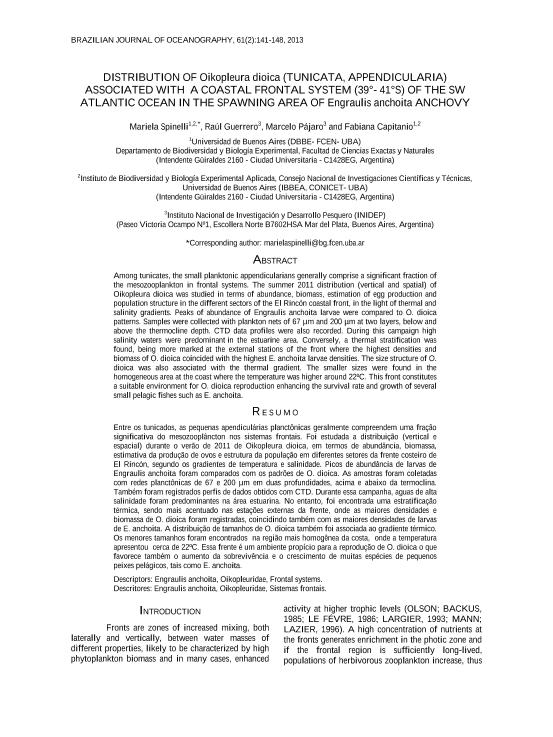Artículo
Among tunicates, the small planktonic appendicularians generally comprise a significant fraction of the mesozooplankton in frontal systems. The summer 2011 distribution (vertical and spatial) of Oikopleura dioica was studied in terms of abundance, biomass, estimation of egg production and population structure in the different sectors of the El Rincón coastal front, in the light of thermal and salinity gradients. Peaks of abundance of Engraulis anchoita larvae were compared to O. dioica patterns. Samples were collected with plankton nets of 67 µm and 200 µm at two layers, below and above the thermocline depth. CTD data profiles were also recorded. During this campaign high salinity waters were predominant in the estuarine area. Conversely, a thermal stratification was found, being more marked at the external stations of the front where the highest densities and biomass of O. dioica coincided with the highest E. anchoita larvae densities. The size structure of O. dioica was also associated with the thermal gradient. The smaller sizes were found in the homogeneous area at the coast where the temperature was higher around 22ºC. This front constitutes a suitable environment for O. dioica reproduction enhancing the survival rate and growth of several small pelagic fishes such as E. anchoita. Entre os tunicados, as pequenas apendiculárias planctônicas geralmente compreendem uma fração significativa do mesozooplâncton nos sistemas frontais. Foi estudada a distribuição (vertical e espacial) durante o verão de 2011 de Oikopleura dioica, em termos de abundância, biomassa, estimativa da produção de ovos e estrutura da população em diferentes setores da frente costeiro de El Rincón, segundo os gradientes de temperatura e salinidade. Picos de abundância de larvas de Engraulis anchoita foram comparados com os padrões de O. dioica. As amostras foram coletadas com redes planctônicas de 67 e 200 µm em duas profundidades, acima e abaixo da termoclina. Também foram registrados perfis de dados obtidos com CTD. Durante essa campanha, aguas de alta salinidade foram predominantes na área estuarina. No entanto, foi encontrada uma estratificação térmica, sendo mais acentuado nas estações externas da frente, onde as maiores densidades e biomassa de O. dioica foram registradas, coincidindo também com as maiores densidades de larvas de E. anchoita. A distribuição de tamanhos de O. dioica também foi associada ao gradiente térmico. Os menores tamanhos foram encontrados na região mais homogênea da costa, onde a temperatura apresentou cerca de 22ºC. Essa frente é um ambiente propício para a reprodução de O. dioica o que favorece também o aumento da sobrevivência e o crescimento de muitas espécies de pequenos peixes pelágicos, tais como E. anchoita.
Distribution of Oikopleura Dioica (Tunicata, Appendicularia) associated with a coastal frontal system (39°- 41°s) of the SW Atlantic ocean in the spawning area of Engraulis Anchoita anchovy
Fecha de publicación:
06/2013
Editorial:
Instituto Oceanográfico
Revista:
Brazilian Journal of Oceanography
ISSN:
1679-8759
e-ISSN:
1982-436X
Idioma:
Inglés
Tipo de recurso:
Artículo publicado
Clasificación temática:
Resumen
Palabras clave:
Engraulis Anchoita
,
Oiikopleuridae
,
Frontal Systems
Archivos asociados
Licencia
Identificadores
Colecciones
Articulos(IBBEA)
Articulos de INSTITUTO DE BIODIVERSIDAD Y BIOLOGIA EXPERIMENTAL Y APLICADA
Articulos de INSTITUTO DE BIODIVERSIDAD Y BIOLOGIA EXPERIMENTAL Y APLICADA
Citación
Spinelli, Mariela Lorena; Guerrero, Raul Alfredo; Pajaro, Marcelo; Capitanio, Fabiana Lia; Distribution of Oikopleura Dioica (Tunicata, Appendicularia) associated with a coastal frontal system (39°- 41°s) of the SW Atlantic ocean in the spawning area of Engraulis Anchoita anchovy; Instituto Oceanográfico; Brazilian Journal of Oceanography; 61; 2; 6-2013; 141-148
Compartir
Altmétricas




